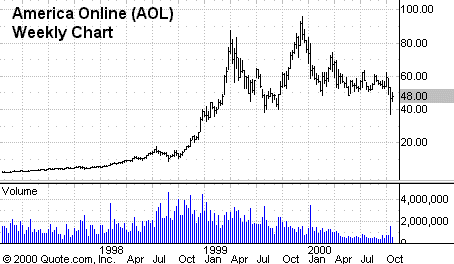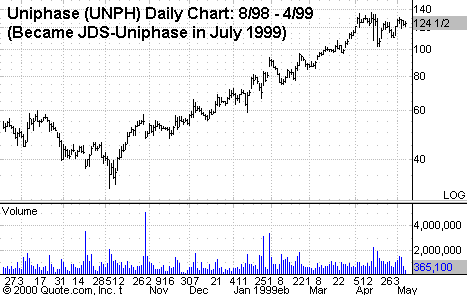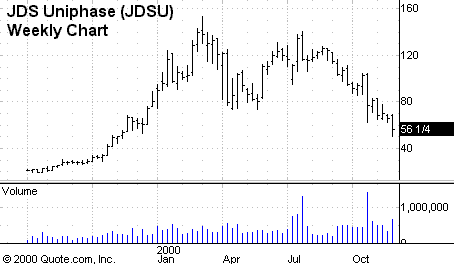Today’s Trading Lesson From TradingMarkets
Editor’s Note:
Each night we feature a different lesson from
TM University. I hope you enjoy and profit from these.
E-mail me if you have
any questions.
Brice
Using Technicals
And Fundamentals To Find Emerging Leaders
By Daniel P. Delaney
Â
One of the
more difficult aspects of trading is the ability to spot the
up-and-coming market leaders that will likely become the next “must own” group
of highflyers. How many times have you heard someone excitedly tell you that a
particular stock is the next Cisco, Intel or Microsoft? Given the speed with
which technology companies appear today, the desire is to find the next America
Online (AOL),
JDS Uniphase (JDSU)
or Juniper Networks (JNPR).
All too often, that “sure thing” turns out not to be such a gem after all.
Spotting the next market monster is tough, especially if you are trying to find
it before everyone else has discovered it.
Usually, by the time the general
market consensus becomes clear, a highflyer is probably already over-owned by
every momentum player, hedge fund manager, mutual fund and even your daytrading
neighbor. As so often occurs, just when these high flyers start to get mentioned
in all the major financial press and websites, they are usually over-extended,
over-hyped, over-owned, and ready for a steep decline. In other words, if you
are buying on the market buzz over a stock, you are probably too late to the
game for that particular stock.
The goal of this lesson, then, is to
get you thinking about how some of the new tech leaders emerge and how you can
go about trying to discover the next round of new technology winners.
Searching For
Leaders
So what is the best way to spot the
up-and-coming winners? Traders have many different styles for spotting the next
round of leaders. Some focus specifically on charts and search for stocks that
hold up the best as the broader market turns downward, with the assumption that
the strongest performers that refuse to cave in will ultimately lead the next
market upswing.
Others look for stocks under
accumulation by the larger money managers and hedge funds. Following promising
chart patterns and tracking price and volume movements help tip a trader off as
to when a potential new star is being born. Obviously, a stock breaking out of a
longer-term base on surging volume is under accumulation by those managers and
institutions that have the highly-paid research departments endlessly searching
and predicting the next round of winners. For this reason, hopping on the train
in front of the big players can sometimes lead to a profitable trade.
Searching Beyond
Charts
Many successful momentum traders will
enter a position knowing only the stock’s pattern setup, relative strength, and
its stock symbol. While many traders are perfectly comfortable at using only
charts to find the up-and-comers, other traders may want to know if there are
ways to find fundamental aspects of a stock that they can use to give them an
extra edge in finding any up-and-coming highflyers. What follows are several
ideas of how to combine fundamental company data that might help give your
trading decision an extra edge.
Obviously, if you are looking for new
high-growth companies, the best place to look is in the technology arena. That
is where the most rapidly growing companies tend to emerge from, and what also
makes them so interesting is that the big Wall Street firms are often not
covering some of the newest emerging technology groups. A perfect example of
this took place in the early days of the Internet explosion. In early 1996,
America Online (AOL)
was demonized by many of the big Wall Street firms who felt AOL used
questionable accounting practices. Within two years, AOL had grown twenty-fold,
and nearly every Wall Street firm was touting AOL with strong buy ratings. The
chart below shows the split-adjusted price of AOL back in 1996 and 1997.

A similar scenario to that of AOL
played out with Amazon (AMZN),
which also faced harsh criticism from analysts before the big firms realized the
millions they could make in embracing the early Internet leaders and taking
public the multitudes that would follow. Amazon became the leading e-tailer, and
with that leadership came big moves in price. Sure, it eventually had problems
in 2000, but the percentage increases as it emerged were spectacular.
As for AOL, just look below what AOL
went on to do once the mainstream analysts and investors finally realized that
AOL would become a profitable media powerhouse. So in this case, it would have
paid to be researching the fundamentals and technology behind AOL. It became one
of the top leaders in the Internet sector, and its biggest moves came long
before Wall Street had noticed it.

Beware: New Sectors
Can Crash
I use the AOL and Amazon charts as
examples because as 1999 and early 2000 showed, traders, investors and Wall
Street took the New Economy mantra to wildly excessive extremes. One by one, the
hot new Internet sub-sectors emerged. In the end, they nearly all had crashed,
but they were definitely worth watching and trading as they ran.Â
Among the sectors that lit up the sky
during the late 1990s were portals, e-tailers, incubators, Internet software,
B2B (business to business), global Internets, wireless, and Internet
infrastructure plays. The infrastructure plays quickly broke into their own
sub-groups like broadband chip makers, networkers, optical networkers, optical
component makers, and even wireless Internet platform makers.
By late 2000, however, many of the
“New New Things” had crashed, along with most of the traditional technology and
telecom leaders on the Nasdaq. So the lesson from that wild run-up was that if
you could find the leaders before everyone knew they were leaders, then there
were some extremely profitable trades to be had. Will this ” Wild West” of the
investment world ever rise again? Who knows, but at least it’s worth learning
about what to look for in these companies, from a fundamental standpoint.
New Leaders Often
Lack Track Records
Since many of these companies ramp up
and go public in just a few short years, there is rarely much of a long-term
track record of revenues, earnings, or price and volume chart action. What,
then, are the best fundamental aspects to look for when you are trying to spot
new leaders? Obviously, with established companies, earnings growth rates are
the key, and ideally these rates should be in the 30% per year or more range.Â
It’s tougher to find winners in the
new sector groups like B2Bs or optical companies that seemingly appear out of
thin air because they don’t really fit into conventional valuation models.
Sometimes they might not even have earnings yet. In fact, this is why so many of
the large Wall Street firms were so late to the Internet-related stock explosion
that occurred. Wall Street is far more comfortable with traditional valuation
models, and for that reason, they remain hesitant to start following what are
essentially concept stocks. For this reason, the big institutions are sometimes
late to the emerging tech sector.
So if new emerging leaders lack Wall
Street-analyst coverage and have recently gone public and lack a longer-term
chart history, you might ask what other ways are there to find these future
leaders?
Becoming Your Own
Research Department
I think the best way to find the new
tech leaders is to read everything. That sounds simple, but if you really
research and learn about enough new companies, you will likely see the trends
and leaders emerge. There are many new technology and financially-oriented
magazines and Websites that track the up-and-comers. Since I personally enjoy
reading and learning about the wide variety of new technology products and
services that continually enter the marketplace, it doesn’t really feel like
work.
Your goal in doing all of this reading
is, in a sense, to become your own research department. It does take time, but
you would be amazed how quickly you will pick up the lingo and jargon regarding
technology companies. As you learn about a new emerging sector, you will notice
that certain names keep popping up. By keeping a list of categories and adding
new emerging names, you will get a feel for who the winners might be. Once you
have potential winners, then keep watching them from a technical standpoint, and
also continue to research them through some unconventional techniques.
Unconventional
Research
Thanks to the Internet, you have
access to more company information than most Wall Street analysts had just ten
years ago. Instantly, you can access earnings reports, Edgar filings, insider
selling, company profiles, management profiles, market capitalization, lists of
a company’s competitors or customers, press releases, analyst’ opinions, and
company financial statements. Sometimes you can even learn a great deal by just
going directly to a company’s Website!
When I find an interesting company
that looks like it might be an emerging leader, I will pull up a company
profile, which is available on nearly every financial portal or Website on the
Internet. Some of the areas I like to check even include such minute details as
a company’s address, who their Venture Capital firm was, who is on their board
of directors, and what educational backgrounds their management might have. So
you might ask, what does this have to do with trading?
Well, say for example that I have a
name from one of my sector emerging leader lists and its stock is beginning to
look great from a technical standpoint. Say it has risen to the higher left side
of a healthy-looking base pattern. By having researched the company thoroughly,
I have extra confidence that the trade will not only work in my favor, but also
might be the start of a large, longer-term move.
A Dream Example
When they asked bank robber Willie
Sutton why he robbed banks, he said because that was where the money was. The
same principle can apply to your emerging-tech research. What I love to see in a
company profile is a company address right in the center of Silicon Valley,
Calif. Menlo Park, Sunnyvale, Redwood City, or Mountain View are great to see.
Then, I like to see that the company founders are engineering types from MIT,
Cal Tech or Stanford. There are also high-caliber tech people from universities
worldwide, especially from top programming havens like India or Sweden. Also
good to see is that the company’s board of directors includes the Chairman of
Cisco or the Dean of Wharton Business School.
For this dream example, the company
might have been partially funded by Sun Microsystems or Microsoft and then
backed by a Venture Capital firm like Kleiner Perkins or Sequoia Capital. To top
it off, say the company supplies software or a specific product that is going to
be used as a standard for wireless Internet access and so on. Obviously, leaders
tend to beget leaders, so I think you get the picture, but the main point is
that this kind of fundamental research can at least move the odds more in your
favor for a trade. And it’s got to be much smarter than getting a tip from a
friend or an Internet chat board!
JDS Uniphase
Example
For instance, I learned about JDS
Uniphase by reading a technology journal in early 1998 when the company was just
called Uniphase. They were a leader in “wave division multiplexing,” which is
the splitting up of light waves so that they can carry data faster and more
efficiently on the Internet. This would supposedly help solve the Internet speed
or bandwidth problem, and by tracking the stock, you would have seen the
emergence of one of the new tech darlings. The company had several of the
“dream” criteria I described above, so it was definitely worth watching.

Uniphase began trading as JDS Uniphase
in July 1999, and as the chart below shows, JDSU soared more than 700% above the
July 1999 price that you see above (The chart below is adjusted for splits).

By late 1999, JDS Uniphase was one of
the most widely held stocks in hedge funds and mutual funds. Yes, it peaked with
the rest of the Nasdaq in March 2000 and sold off, but it still maintained solid
gains above the mid-1999 levels.
By researching JDSU early enough and
developing an understanding about the sector (optical networking), you would
have had all the more confidence in the stock as you saw the stellar chart
pattern unfold in late 1998 and 1999. Thus, by blending your tech research with
technical analysis, you can increase your odds of finding one of the
up-and-coming tech monsters.
Closing Remarks
While trying to find the next round of
emerging leaders might take a lot of reading and research, it really does keep
you up-to-date on the rapidly changing technology sector. Since some of these
newer technologies have no track record, it would almost make more sense for an
engineer or software programmer to find the emerging leaders. But as a trader,
just applying some of these basic fundamental principles and tracking your
leaders list, you can likely get a trading edge that will help you make smarter
decisions.
Â
